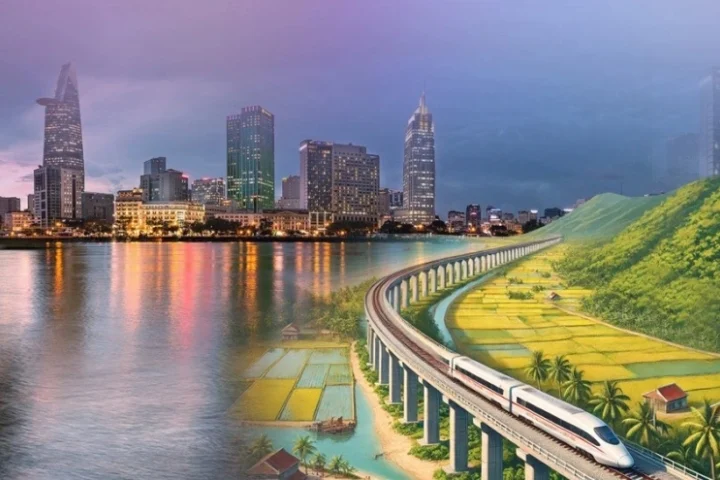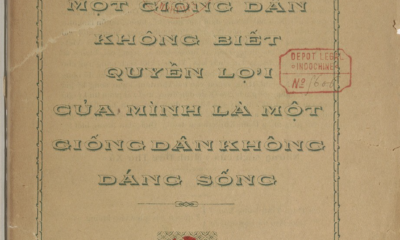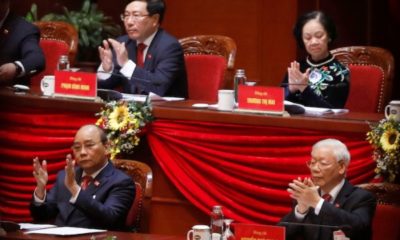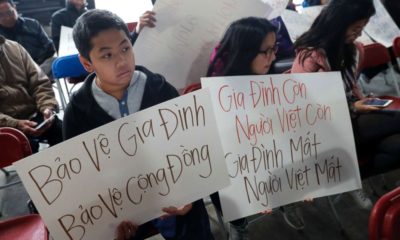Politics & Economy
Reflections on New Era of National Rise by Vietnam General Secretary Tô Lâm
Published on

(A propaganda painting for “the new era of national rise” in Vietnam)
Chu V. Nguyen, Ph.D.
Chairman of Tropical Star Enterprise, Inc.
Former Associate Professor and FAEIS Dept. Chair, University of Houston Downtown
Abstract
The purpose of this article is to synthesize and compare the political and economic institutions of the Communist Party of Vietnam (CPV) with those historical political and economic institutions identified and explained by Nobel laureate economists to argue that the CPV’s single-party, dictatorial, totalitarian regime has imposed extractive political and economic institutions. Two scholars, North (Nobel laureate in Economics, 1993) and Thomas, argue that such “institutions” do not provide “mechanisms” that encourage/motivate positive economic initiatives, thus preventing sustainable economic development. Recently, three scholars awarded the Nobel Prize in Economics in 2024, Acemoglu, Johnson, and Robinson, identified that countries with a history of sustainable economic development have implemented and enforced inclusive political and economic institutions, whereas those that have imposed extractive political institutions and extractive economic institutions have failed.
Statistical data provided by Vietnam and archived by the International Monetary Fund show that Vietnam’s economic performance is abysmal. The statistics support the conclusions of these Nobel Prize economic experts. Given the recent U.S. reciprocal tariffs and the aforementioned, the inevitable inference is that, for sustainable economic development, Vietnam should carefully navigate its foreign policy choices, ensuring it does not become overly dependent on either the U.S. or China on the international arena and change the government structure at home; i.e., changing the polity, to establish and implement inclusive political and economic institutions. However, if the goal of the polity is to protect the Party and the interests of its members, the political and economic institutions cannot be inclusive. Therefore, the vision of success for the new era of national ascent envisioned by General Secretary Tô Lâm is improbable unless he and the VCP change the polity.
Introduction
Depending on the nature of the “polity,” the causality/interference between economic development and the sustainability of a country’s polity can be mutually supportive/symbiotic or mutually antagonistic/hostile (positively/negatively bidirectional causality). The term polity here is “a concept in political science, used to refer to the form of organization and management of a country or a political organization.” The direction and time for the causality/interference processes (symbiotic or antagonistic) to be completed depends on the political and economic institutions the polity deploys and pursues. In this article, causality/interference includes Granger causality/interference.
It is indisputable that Vietnam is a country characterized by dictatorship, single-party rule, and totalitarianism. Therefore, with the power of the police and public security forces and the capability to criminalize any citizen’s actions, the Party and officials possess extensive power/ability to control/”mobilize” or suppress the masses compared to the governments of democratic countries.
One proof that the police serve as the protector/shield of the Party and government officials is the Ministry of Public Security budget allocation compared to the Ministries of Defense, Health, and Education and Training. The budget for 2024 was approved by the National Assembly on November 10, 2023, and published on the National Assembly website in early December 2023. According to this resolution, the budget allocations are as follows: VND 113.271 trillion for the Ministry of Public Security, and 270.024, 7.010, and 7.711 trillion VND, respectively, for the Ministries of Defense, Health, and Education and Training.
Furthermore, contemporary economic development theory presents two opposing schools: inward-looking (Prebisch-Singer Development Hypothesis) and outward-looking (Washington Consensus Development Hypothesis) theories to drive economic development. Vietnam’s strategy for economic growth has been an outward-oriented development model since the reforms. Additionally, economic development is characterized as a “putty-clay process” (Singer, 1998). This theory explains that if economic development policies are improperly devised or executed incorrectly, the cost will be immense—in terms of not only capital, but human resources, and time. Furthermore, it may even be impossible to correct these errors post-implementation.
The Vietnam War, in which the Communist Party of Vietnam used the method of struggle along with a culture of “ Rather kill mistakenly than to miss an enemy”, ended fifty years ago, and the country has since been “unified”. “Moreover, the motto of the Socialist Republic of Vietnam is a government “of the people, by the people, and for the people,” affirming that the goal of all government policies is the welfare of the people, encapsulated in the slogan/principle that “the people are the roots.” However, the reality is entirely different.
Unfortunately, for humanity, there has never been an exception; after seizing political power the communist regime has always been more brutal than the regimes they struggled to overthrow, through violent actions to impose the principle that “minority rules and majority are exploited”. This minority governed by the culture of Marxist-Leninist theory.
The method and goal of the power struggle, according to Marxist-Leninist theory on the armed seizure of power, involves fighting for social class, utilizing the strength of the oppressed majority to overthrow the repressive ruling minority. This is followed by tightly controlling every aspect of the life of the vast majority in a “tyrannical” manner. Furthermore, today, the CPV has shifted from its “self-proclaimed and self-appointed role as the leader of the oppressed class, or the proletariat,” in the conquest of the South to “the leader of a single-party, dictatorial, and totalitarian regime oppressing nearly 100 million non-Party members.”
More importantly, observers recognize the CPV as a source of protection and a shield both domestically and internationally. Notably, through the police force, it appears that nearly 50 years after its establishment, the Party’s and the government’s institutions in Vietnam have not only maintained their long-held power to tightly control all aspects of the people’s lives without showing signs of weakening or facing serious threats but have also become increasingly stringent and oppressive over time.
Meanwhile, under the same regime, the bidirectional causality between Vietnam’s economic development and polity can only be interpreted as a detrimental relationship. Evidence of this is the “Đổi Mới” (Renovation) policy introduced by the CPV, which required a shift from the traditional centrally planned economic model of Marxist-Leninist doctrine to a “market economy with socialist orientation” in the late 1980’s to preserve the Party and the privileges of its members. This transformation dismantled several economic barriers, allowing the populace some limited economic freedom. Along with USD 2 billion in remittances from those labeled as “scum and thugs following the American empire,” helped Vietnam escape a severe economic crisis.
However, the “market economy with a socialist orientation” strategy has established numerous new barriers to protect the Party and increase opportunities for party members to engage in corruption involving money and power. Consequently, more than 30 years later, Vietnam’s economy is teetering on the brink of the middle-income trap, a situation the Party and government have been unable to resolve despite receiving over $16 billion annually in remittances from a group that the Party now refers to as “Khúc ruột ngàn dặm” (can be translated into English as “A thousand-mile gut” literally, but its actual meaning is more figurative. It is a Vietnamese phrase often used to refer to Vietnamese people living far from their homeland, especially in overseas Vietnamese communities. A more natural translation would be “The distant homeland’s heart” or “Expatriates from afar”). This economic institution has failed to maximize the welfare of the non-party members of the populace.
Beyond economic challenges, issues of “self-evolution” and “self-transformation” among party cadres and members, as well as the predominantly pro-American sentiment of the Vietnamese populace compared to other Southeast Asian nations (Shambaugh, 2021), necessitate that the Vietnamese Party and officials upgrade relations with the United States to a Comprehensive Strategic Partnership, urging the U.S. to recognize Vietnam’s market economy status. Furthermore, the issuance of Decree No. 1334/QĐ-TTg, Directive 24-CT/TW, Resolution 39-NQ/TW on July 18, 2023, and more recently, Resolution 18-NQ/TW on September 27, 2024, concerning institutional streamlining, aims to make the government machinery and the Party more efficient. These measures are not merely administrative but strategically aim to attract intellectual and financial resources from overseas Vietnamese under the rapidly promoted slogan of entering “A New Era of National Rise”, championed by General Secretary Tô Lâm of the CPV. The Party and officials employ these tools to find solutions for the economic difficulties they have created, which they have been unable to resolve, to preserve the Party and the vested interests of its elite members.
For the reasons outlined above, the purpose of this article is:
- To synthesize the political and economic institutions of the CPV and compare them with historical political and financial institutions that Nobel Prize-winning economists have identified and explained to argue that the CPV’s single-party, dictatorial, and totalitarian regime has imposed extractive political institutions and extractive economic institutions in the country.
- To compile explanations by two scholars, North (Nobel laureate in Economics, 1993) and Thomas, who argue that a “single-party,” dictatorial, and totalitarian “institution” does not provide “some kind of mechanisms” to encourage or incentivize positive economic initiatives, thereby hindering sustainable economic development.
- To synthesize the findings of three Nobel laureates in Economics in 2024, Acemoglu, Johnson, and Robinson identified that historically, countries with sustainable economic development have implemented and enforced inclusive political and economic institutions, while those countries which have imposed extractive political and economic institutions have failed.
- To summarize a selection of statistical data provided by the Vietnam government and archived by the International Monetary Fund, which indicates that Vietnam’s economic performance is exceedingly poor, to argue that these statistics seemingly confirm or support the observations and conclusions of financial experts.
- Based on the analyses mentioned above, to propose that for sustainable economic development, Vietnam must undertake a second reform; this entails transforming institutions to enable the deployment and enforcement of inclusive political and financial institutions.
- Finally, in conclusion, the author expresses concern that since the institution’s goal is to protect the Party and the interests of its members, the political and economic institutions cannot be inclusive. Therefore, the vision of success for the “era of national ascent” under General Secretary Tô Lâm appears highly improbable unless he and the CPV undertake significant institutional changes.
2. The Nature of Political and Economic Institutions and Issues in Education and Regional Geopolitics.
2.1. Political Institutions
Following 1975, the single-party, communist regime adopted the rationale of “party nominates, people elect,” and a labor allocation process based on the principle of “hồng hơn chuyên – rather red than professionalism” (hồng: adhering to Communist ideology; chuyên: expertise or specialization); within the traditional centrally planned economic system where communal property, particularly land, was predominant. This arrangement resulted in concentrated political and consequently economic control in a small group within the Socialist Republic of Vietnam. This economic institution led the country into extreme hardship and a severe economic crisis. This crisis threatened the existence of the Communist Party and the institution in the early 1980s. Evidence of this is the Sixth Party Congress at the end of 1986, which concluded with the slogan “Reform or Die” (Kleinen, 2015).
2.2. Economic Institutions and Consequences
Vietnam introduced the Đổi Mới in 1986, which theoretically transitioned the economic activities from a “centrally planned” model to a “socialist-oriented market economy. This transition began when international financial institutions, such as the International Monetary Fund and the World Bank, the US Department of Finance, along with leaders from advanced countries advocating neoclassical economic theories, preached that the contemporary economic development strategy involved developing the manufacturing sector for export. This policy, known as the “Outward-oriented economic development Policy,” posits that foreign trade and the industrial sector are central to or spearheading the national economic development strategy. Naturally, these international financial institutions encouraged and supported countries to pursue this outward-looking economic development strategy. Inevitably, the “market economy” segment of Vietnam’s economic development plan relies on an export-driven or outward-oriented economic development strategy.
The nature of the “market economy, socialist orientation” model is essentially two conflicting, opposing economies. Vietnam does not have an actual market economy. In reality, the socialist economy guides the market economy. Consequently, the private sector, including foreign-owned enterprises, are unfairly treated. Moreover, although the political environment is “stable,” it lacks democratic freedom, respect for human rights, and property rights. However, the domestic laws of international trade partner countries mandate these freedoms must be fulfilled and enforced in the agreements that Vietnam has committed to, such as the Comprehensive and Progressive Agreement for Trans-Pacific Partnership (CPTPP) and the European Union-Vietnam Free Trade Agreement (EU-VFTA).
Regarding the implementation and execution of Vietnam’s economic development strategy, two scholars with significant expertise and understanding of Vietnam, Professors Klingler-Vidra and Wade (2020), in their research titled “Science and Technology Policies and the Middle-Income Trap: Lessons from Vietnam,” suggest that Vietnam has been considered by many in the economic development research community as a potential new Asian Tiger. They argue that since the early 2000s, Vietnam has rapidly advanced in income and technology. Evidence of this includes Intel’s inauguration 2010 of its largest chip manufacturing center outside the United States, seemingly confirming Vietnam’s status as an emerging information and communication technology nation. Other large Western, Japanese, and South Korean multinational corporations, such as Samsung, Fujitsu, and Toshiba, have also established manufacturing facilities in Vietnam.
During the same period, Vietnam progressed beyond the World Bank’s classification from “low- income” to “low-middle income” in 2010. The government, donors, and aid organizations began to address the “middle-income trap” as an impending critical issue for Vietnam. To position “science and technology policy “as a strategic tool for sustaining economic growth and preventing the middle-income trap., authorities looked to China’s science and technology policy as a model, citing Intel’s $1 billion investment in Vietnam as evidence of an emerging technology hub. However, in subsequent years, Vietnam’s science and technology policy faltered, with efforts predominantly aimed at increasing the number of startups in the style of Silicon Valley rather than implementing and enforcing a comprehensive science and technology policy suited to the Vietnamese socio-economic environment to enhance productive capacity, or pursuing a strategy akin to “Made in China 2025”.
Therefore, in assessing the potential “success” of Vietnam’s science and technology policy, Klingler-Vidra and Wade (2020) lament that: “Rather than investing in technology and expertise, Vietnamese enterprises still predominantly rely on the advantages of cheap labor and raw material exploitation. The so-called high-tech companies remain small and compete internationally almost entirely on cost, not innovation or quality.”
Regarding the structure of the economy, Busch (2017) remarked, “Vietnam’s cautious and orderly adoption of market institutions has yielded over two decades of impressive economic performance, while the fundamental political economy of the country remains largely intact.” He further noted: “ However, successful economic restructuring also contributes to Vietnam’s central economic challenge today, explicitly addressing the ‘missing intermediary’, i.e., the absence of an effective domestic private sector.”
Regarding the challenges in macroeconomic activities and the inevitable issues related to economic growth, it is not that the Communist Party and the leadership of Vietnam are unaware despite numerous economic development strategies proposed by experts and scholars. Both domestic and international (such as the World Bank and Vietnam’s Ministry of (Planning and Investment, 2016), the Party and Vietnamese officials continue to foster an economic culture that Professor Dr. Chu Nguyen (Nguyen, Hiệp, Lộc; 2021) describes as a development strategy that is “self-serving, meticulous, and selective in choosing partners for development”, in his critical remark. The inevitable consequence of this strategy is transforming the nature of Vietnam’s economy into what the media mockingly calls “The Project Economy”. This term implies that the Party and Vietnamese leaders lack a genuine strategy for economic development; instead, they focus on devising projects that facilitate opportunities for corruption and patronage.
In other words, the project-based economy refers to an economy where projects executed by government officials are primarily aimed at personal gain rather than as functional components of the country’s economic development strategy. This type of economy has maximized the opportunities and extent to which corrupt officials could exploit resources as they had anticipated. Consequently, the inevitable outcomes of this culture have been statistically documented in Vietnam: the 2024 Article IV Consultation-Press Release (part of Table 1 below), which has directly and indirectly exposed these issues (IMF, 2024). The practices of the Communist Party and Vietnamese leadership have significantly hindered economic development and brought Vietnam to the threshold of the middle-income trap. Therefore, this difficulty is self-inflicted and, as it appears now, beyond the current regime’s ability to remedy.
Another significant issue is the importance of agricultural products in Vietnam’s export portfolio, particularly rice and aquaculture, and the worsening salination, which is currently and will continue to cause severe damage to Vietnam’s agriculture and aquaculture processes. It is difficult to dispute those flaws in the policy development for science and technology, along with issues in agricultural and aqua- cultural practices, will lead to numerous negative consequences for Vietnam’s economic growth and foreign trade in the future.
2.3. Consequences of Political Institutions and Regional Geopolitical Issues
2.3.1. Education
Regarding education, the educational system in Vietnam is described by Truyết (2025) and Bình (2025) as significantly outdated, failing to keep pace with the country’s economic development and deteriorating in all aspects over time. Despite the workforce being affordable, diligent, and valuing education, there is a notable lack of skills due to the national education curriculum not adapting to the employment market’s needs. This situation is compounded by a rampant culture of diploma fraud, particularly prevalent among government officials. A notable example is Intel’s inability to recruit sufficient local staff upon entering the Vietnamese market. Learning from Intel’s experience, Samsung has sent Vietnamese employees abroad for training. In 2021, Apple had to employ staff from the U.S. for its operations in Vietnam as the local infrastructure began. The poor state of infrastructure is evident from the condition of significant ports, roads, bridges, utilities and widespread pollution.
In Vietnam, the single-party regime has delegated economic control to a small circle of loyalists and cronies. This is not due to a lack of awareness by the government but rather a deliberate strategy, as the leadership seems to prioritize implementing and enforcing projects that offer their personal benefits. This approach has led to the rise of a “project-based economy”. Klingler-Vidra and Wade (2020) point out that “…the Vietnam 2035 report, which was widely released in February 2016, recommends that the government ‘strengthen’ and ‘coordinate’ its science and technology system as a priority to ‘avoid falling into the middle-income trap and falling behind’ (World Bank & Vietnam Ministry of Planning and Investment, 2016). In November 2018, Dr. Chu Ngọc Anh, the Minister of Science and Technology of Vietnam, declared, “Vietnam needs to develop a national strategy” (Akhaya, 2018). Klingler-Vidra and Wade (2020) report that “Immediately after the release of the Vietnam 2035 report in May 2016, Government Resolution 35 sets further targets to support innovative startups. The targets include a plan to create 5,000 small and medium-sized enterprises focusing on science and technology and 30 high-tech enterprises and development centers between 2016 and 2020. Klingler-Vidra and Wade (2020) lament that, like many of the targets mentioned before; for example, in 2011, the announcement to train 80,000 engineers, technicians, and managers of small and medium-sized enterprises by 2020 gave these numbers without any basis or analysis.”
2.3.2. Corruption Issues
The Party rules and degree supersede national law, adhering to the principle of “the Party nominates, the people elect”, or more accurately, “the Party appoints”. The “furnace burning” (Đốt lò) campaign initiated by the late General Secretary Nguyễn Phú Trọng and now intensified by the new General Secretary Tô Lâm, ostensibly continues to target political adversaries.
On a larger scale, the project to implement Resolution No. 18-NQ/TW of the 12th Party Central Committee (issued in 2018) currently, “Streamlining the administrative apparatus: The Second Renovation of the Country,” by General Secretary Tô Lâm, is even more insidious than the goal of the furnace campaign of the late General Secretary Nguyễn Phú Trọng. It aims to eliminate political rivals, consolidate personal power, and seize lucrative economic assets for the Ministry of Public Security and the Hưng Yên interest group. The administrative machinery continues to perform poorly. The legal framework is cumbersome and often presents contradictions between Party and governmental laws, with some not meeting international standards. The bureaucracy still encompasses two vast and costly systems, even post-streamlining the state and the Party. The personnel of both the Party and the state lack professional competence, ethical integrity in administration, and transparency.
Corruption occurs everywhere and will continue to do so. Furthermore, the pervasive corruption in Vietnam is a product of the single-party system, essentially embedded in the DNA of the communist regime, its institutions, and the structure of public authority. Created and condoned by the polity itself, this severe corruption permeates all levels from top to bottom, acting as a super virus that spreads across various sectors in Vietnam to such an extent that even party-aligned leaders and media acknowledge its excessive severity. The investigations of the “furnace burning” campaign have revealed numerous corruption cases that have cost the country billions of dollars, involving high-ranking party members appointed by the Party through its personnel selection process for positions of power, some of whom have subsequently been prosecuted, removed and, in some cases, sentenced to death.
However, those who replace them will continue to operate within the same system of rewards, punishments, and incentives; therefore, they are likely to follow in their predecessors’ footsteps, that is, they will engage in corruption. This indicates that anti-corruption efforts in the Vietnamese style will never be successful because the political structures that encourage corruption remain intact. Consequently, without institutional change, the behavior of those within the system will not change: the approach of “old vase, new wine” will not resolve the corruption issue in Vietnam.
Evidence that corruption remains a persistent issue in Vietnam is reflected in the following media reports. Despite a prolonged and extensive anti-corruption campaign proclaimed by the late General Secretary Nguyễn Phú Trọng, who made empty promises using slogans such as “no forbidden zones, no exceptions, regardless of who it might be”. Regardless, mainstream media report in the first half of 2024, the police detected over 3,000 cases of corruption, economic crimes, and smuggling—an increase of 21.63% compared to the same period in 2023. Prosecutorial authorities initiated 2,836 instances involving 5,975 suspects for corruption, economic, and official misconduct; the Government Inspectorate uncovered violations involving over 92.739 trillion Vietnamese dong and 299 hectares of land; and throughout 2024, authorities detected 956 corruption and official misconduct offenses and prosecuted 2,418 defendants for corruption-related crimes (https://baochinhphu.vn/6-thang-dau-nam-phat-hien-hon-3000-vu-pham-toi-tham-nhung-kinh-te-buon-lau-102240708174427336.htm ).
2.3.3 Geopolitics
Regarding strategic geography, the Philippines has agreed to allow the United States access to all nine military bases (The Economist, February 21, 2023) around the Luzon archipelago, an area also contested between the Philippines and China. Japan has doubled its defense budget, and the emergence of the AUKUS and QUAD alliances and several other ongoing shifts in the region could negatively impact Vietnam’s significance in the future Asian strategy of the U.S. and its allies.
2.3.4. Vietnam’s geopolitical and economic dilemma as the results of the U.S. reciprocal tariffs
Even though the stated objective of the U.S. reciprocal tariffs is to address trade imbalances by imposing higher tariffs on countries where the U.S. runs a trade deficit, the real objective is to address the non-tariff barriers imposed on the US by its trading partners. Thus, by imposing the reciprocal tariffs the U.S. seeks to:
- Promote fairness in global trade by countering non-reciprocal trading arrangements.
- Support domestic industries through reindustrialization and reducing reliance on foreign imports.
- Retaliate against unfair trade practices such as excessive tariffs, discriminatory taxes, and non-tariff barriers imposed by other nations.
- Enhance U.S. competitiveness by reducing the trade deficit and bolstering economic and national security.
However, it is hard not to conclude that the actual objective of the U.S. reciprocal tariffs is to counter the China’s challenge of the U.S. Homogeny. Clearly, the U.S. reciprocal tariffs definitely has thrown the world into disarray. Due to its geopolitics, the polity and attendant policies which Vietnam has pursued in the last fifty years, the challenges for Vietnam would face an extremely difficult challenge to maintain strategic autonomy while safeguard its economic and political interests.
2.3.4.1. Short-term challenges in leaning towards the U.S. or China
Vietnam finds itself at a crucial crossroads in international relations, navigating the complex dynamics between the United States and China. Both superpowers offer strategic advantages and pose significant challenges. As Vietnam seeks to balance economic growth, national security, and regional stability, it must carefully weigh the costs of leaning toward either side.
i. Challenges of Aligning with the United States
If Vietnam strengthens ties with the U.S., several benefits could emerge, such as increased trade opportunities, investment inflows, and greater access to advanced technology. However, this alignment comes with its own set of difficulties:
- Economic dependence: While deepening economic ties with the U.S. could accelerate Vietnam’s economic development, it might also lead to an overreliance on American corporations, affecting the autonomy of domestic industries.
- Political pressure: The U.S. often promotes democratic values and human rights in its foreign policy. Greater alignment could bring scrutiny on Vietnam’s internal governance, potentially leading to diplomatic tensions and may threaten the power of the Vietnam’s Communist Party as well as its attendant political objectives.
- Regional backlash: Strengthening ties with the U.S. may provoke negative reactions from China, Vietnam’s largest trade partner. China could impose economic sanctions or escalate territorial disputes in the Western Pacific to pressure Vietnam.
- Potential damage to Vietnam’s agriculture and aquaculture sectors: China could use dams on the upper Mekong River to reduce its flow and volume of water, which would definitely increase the degree of salinity in the Mekong Delta, causing serious damage to Vietnam’s agriculture and aquaculture sectors.
ii. Challenges of Aligning with China
On the other hand, leaning toward China could solidify the power of the Vietnam’s communist Party, power and benefits of members as well as their cronies. China is a dominant force in manufacturing, trade, and infrastructure development. However, closer ties with China pose several risks:
- Sovereignty Concerns: Vietnam has long-standing territorial disputes with China, particularly in the South China Sea. Aligning too closely with China could compromise Vietnam’s ability to assert its sovereignty over disputed waters.
- Economic Vulnerabilities: While trade with China is essential, Vietnam may become too dependent on Chinese supply chains; facing onslaughts of similar China’s commodities but low prices due to governmental subsidies and economies of scale in productions; therefore, reducing its flexibility in responding to global economic shifts and potentially its position in Asia’s regional economic framework.
- Domestic Resistance: Many Vietnamese citizens remain skeptical about Chinese influence, given historical tensions and concerns over economic and political interference. Aligning with China could spark public dissent and unrest.
Thus even though it is a daunting task, but to maximize the welfare of the populace, Vietnam must carefully navigate its foreign policy choices, ensuring it does not become overly dependent on either the U.S. or China. A balanced approach—maintaining strong economic ties with both while securing national interests—may be the most prudent path forward. And its ability to manage these complex relationships will be critical to its long-term stability and prosperity.
2.3.4.2. Long-term consequences in leaning towards the U.S. or China
It is very hard to repudiate that Vietnam’s alignment decisions would shape its future in profound ways, influencing its economy, security, and regional influence. Here are some potential long-term effects:
i. Economic Stability or Vulnerability:
- If Vietnam leans toward the U.S., it may benefit from increased foreign investment, technological advancements, and trade diversification, reducing dependence on any single market.
- If it leans toward China, Vietnam might secure a steady supply chain for manufacturing and infrastructure projects but risk economic overreliance, making it vulnerable to shifts in Chinese policies.
ii. Geopolitical Influence and Sovereignty:
- Stronger U.S. ties could position Vietnam as a key player in regional security alliances, reinforcing its stance in territorial disputes like those in the South China Sea. However, this could strain relations with Beijing.
- Greater alignment with China might bring economic rewards but could undermine Vietnam’s ability to assert sovereignty, particularly regarding maritime conflicts.
iii. National Security and Military Strategy:
- Strengthened U.S. relations could mean deeper defense cooperation, access to advanced military technology, and participation in strategic alliances like the Indo-Pacific framework.
- Closer ties with China might reduce immediate security tensions but could limit Vietnam’s defense autonomy, as Beijing’s regional dominance grows.
iv. Domestic Political and Social Impact:
- A U.S. tilt may encourage political reforms, aligning Vietnam more with Western governance models, which could lead to internal debates on human rights and democratic development.
- A China-leaning stance could reinforce stability under existing governance but might face resistance from segments of the population wary of Chinese influence.
Ultimately, Vietnam’s challenge is to maintain strategic autonomy—leveraging both relationships while safeguarding its economic and political interests. A balanced approach could minimize risks and maximize long-term benefits. The key will be adaptability in a rapidly shifting geopolitical landscape.
- Requirements for a Strategy to Develop an Economy
An interesting point by Professor Lewis (1955) suggests that governments can slow economic growth by allocating too many societal resources to constructing monuments or town halls, as the profitability of these projects is very low. Nevertheless, the ongoing maintenance costs after completion are exceedingly high. Published in 1955, his critique was directed at such constructions in Russia and the Eastern Bloc. However, in the past two decades, Vietnamese domestic media has proudly reported on many large-scale monument constructions, village gates, and massive cultural establishments. Recently, opulent museums with astronomical annual operating and maintenance costs, while hospitals lack both facilities and medications, students, the nation’s future, must cross rivers in styrofoam boxes due to the absence of bridges and share packets of instant noodles daily.
3.1. Elements Needed for a Contemporary Development Strategy over Time
For sustainable development, a nation’s economy must continually grow and evolve, especially in developing countries, to avoid what Gill and Kharas (2008) describe as falling into a “middle-income trap”. This trap hypothesizes that countries advancing from “higher low-income” to “low middle-income” status may experience a slowdown in growth that they had seen in previous decades. This slowdown occurs because the increase in production productivity does not keep pace with rising production costs; in other words, the productivity growth lags behind the increase in production costs.
Sustainable development means that the economy must continue to grow; it cannot just grow for a period, slow down, and then stagnate. Doner and Schneider (2016) noted, “Of the 101 middle-income economies in 1960, only 13 had achieved high-income status by 2008. Today’s middle-income countries are caught in a developmental nutcracker: ‘… unable to compete with low-income, low-wage economies in export manufacturing and unable to compete with advanced economies in high-skill and high-technology areas’”
Rapid changes in the international marketplace over the past three decades have made governments’ roles and responsibilities in correctly designing, implementing and enforcing policies more challenging and complex. Kang and Paus (2020) argue that these are challenges that successful technological adopters in East Asia, such as South Korea, Taiwan, and Singapore, have not faced previously. Therefore, the need for “government to get it right”, as Professor Lewis advocated, becomes crucial if a country hopes to avoid falling into the middle-income trap.
Furthermore, Kang and Paus (2020) argue that an exclusive focus on domestic factors is insufficient to provide a comprehensive framework for understanding or escaping the middle-income trap; a situation in which a country’s growth slows after reaching middle-income levels. Such an approach fails to account for two critical challenges faced by middle-income countries:
i. The complex internal difficulties involved in upgrading and strengthening domestic innovation capabilities require practical synergy and interaction among interrelated factors.
ii. The impact of external forces, which evolve and, when combined with domestic factors, create substantial obstacles to advancing innovation-driven economic activities.
Given these challenges, Kang and Paus (2020) assert that any effective strategy to overcome the middle-income trap must be rooted in economists’ and political scientists’ research and theoretical insights.
Additionally, Kang and Paus (2020) believe that focusing solely on domestic factors does not provide a valuable framework for understanding or escaping the middle-income trap. Such an approach overlooks two critical challenges that middle-income countries face:
- Promote the development of domestic productive capacities to upgrade and increase the growth rate of productivity development of production factors (capital and labor force);
- Timely response to or exploitation of international interactions with domestic factors, as these interactions will change over time and may present challenges to domestic innovation or opportunities for plans to increase productivity growth; and
- Understand the nature of government-private sector linkages and simultaneously leverage them to maximize productivity growth.
Moreover, Raj-Reichest (2020) emphasizes that recommendations for escaping the middle-income trap and catching up with high-income economies require essential prerequisites. Chief among them is the presence of a high-quality higher education system, encompassing both natural and social sciences; substantial government investment in research and development; and the implementation of difficult structural reforms to phase out outdated companies and obsolete technologies that no longer align with the demands of the modern era.
At the same time, Raj-Reichest (2020) highlights that countries that have successfully transitioned beyond middle-income status, such as South Korea and Taiwan, have benefited from strong support from large domestic enterprises. These businesses have played a crucial role in enhancing education systems to meet the growing demand for a highly skilled and adaptable workforce, ensuring that national economies remain competitive in an ever-evolving global landscape.
3.2. Evolution of Development Strategies over Time
For nearly a century, following John Maynard Keynes’s (1936) introduction of Keynesian Economics as a macroeconomic framework aimed at pulling the global economy out of the Great Depression that began in the late 1920s, two contrasting economic development strategies emerged. First is the inward-looking development strategy also known as the Prebisch-Singer Hypothesis or Prebisch-Singer Thesis, rooted in Keynesian economic theory (Singer, 1998). The second is the outward-looking development strategy, which is based on Neoclassical economic theory and later became known as the Washington Consensus economic development strategy.
The term “Washington Consensus” was first introduced in 1989 by British economist John Williamson. International financial institutions heavily promoted the outward-looking development strategy, such as the International Monetary Fund (IMF), the World Bank, and the U.S. Treasury Department. Developed nations strongly supported it during the 1980s and 1990s. This approach mandated policies emphasizing free-market principles, including trade liberalization, privatization, and financial liberalization, as well as fiscal and monetary policies aimed at reducing fiscal deficits and controlling inflation. These policies set the foundation for the modern era of globalization.
In contrast, the Prebisch-Singer Hypothesis argues that the long-term decline in the relative prices of primary commodities compared to manufactured goods leads to deteriorating terms of trade for economies dependent on primary product exports. Raúl Prebisch and Hans Singer developed the inward-looking development strategy in the late 1940s, and it has since been a cornerstone of Dependency Theory and policies such as import-substitution industrialization (ISI). This approach served as the foundation for Latin American governments to subsidize the import of machinery and equipment while fostering workforce development, ultimately aiming to strengthen domestic market purchasing power.
An interesting development in the transition between these two aforementioned competing economic paradigms was the work of Douglas C. North, recipient of the 1993 Nobel Prize in Economics and his co-author Robert P. Thomas. In their seminal study, The Rise of the Western World (1973), they concluded that effective economic institutions are the primary determinants of long-term economic growth, as measured by a per capita long-run rise. Their research emphasized that societal progress would stagnate without incentives for economic initiative.
North and Thomas (1973, p. 2) further argued that:
“First we must isolate the type of growth of income which results from increases in the inputs of productive factors (land, labor, capital). Such direct increments lead to overall (extensive) growth but not necessarily to increases in income per person. Two situations can precipitate the latter sort of per capita improvement which we designate as true economic growth. On the one hand, the actual quantities of the per capita factors of production may increase. On the other, an increase in efficiency on the part of one or more of the factors of production will result in growth. Such increase of productivity can come about through realization of economies of scale, because of improvements in the quality of the factors of production (better educated labor, capital embodying new technology) or because of a reduction in those market imperfection that result from uncertainty and information costs, or as a result of organizational changes that remove market imperfections.”
Additionally, according to North and Thomas (1973), economic historians have long attributed technological change as the primary driver of Western economic growth, given that European economic history is deeply intertwined with the Industrial Revolutions. More recently, scholars and experts have argued that investment in human capital is the key factor behind economic expansion. Today, researchers are beginning to explore the growth-enhancing effects of reducing market information costs. Indeed, each of these factors—technological innovation, human capital investment, and improved market efficiency—has significantly contributed to increased economic output. Economies of scale have also played a crucial role, mainly through production for expanding markets. Since economic growth is measured by a per capita long-run rise, population growth is an additional variable in the determination of sustained economic growth.
North and Thomas (1973) lament that these widely cited explanations are innovation, economies of scale, education, and capital accumulation. Economic historians and economists have consistently referenced them as determinants of economic growth. However, they identify a critical flaw in this reasoning:
“If all that was necessary for economic growth were investment and innovation, why have some societies failed to achieve the desired outcomes?”
To address this fundamental question, North and Thomas (1973, p.2) argue that the factors listed above—technological progress, economies of scale, education, and capital accumulation—are not the causes of growth; they are growth. Long-term economic growth, they contend, will not occur unless the existing economic organization is efficient.
According to North and Thomas (1973, p. 2):
“Growth will simply not occur unless the existing economic organization is efficient. Individuals must be lured by incentives to undertake the socially desirable activities. Some mechanism must be devised to bring social and private rate of return into closer parity. Private benefits or costs are gains or losses to an individual participant in any economic transaction. Social costs or benefits are those affecting the whole society. A discrepancy between private and social benefits or costs means that some third party or parties, without their consent, will receive some of the benefits or incur some of the costs. Such difference occurs whenever property rights are poorly defined or not enforced, if the private costs exceed the private benefits, individuals ordinary will not be willing to undertake activity even though it is socially profitable.”
North and Thomas (1973) emphasize that long-term growth occurs only when total national income rises faster than the population. Conversely, a static or non-growth state does not generate a sustainable increase in per capita income, even though average income may fluctuate in short—or medium-term cycles. A state of stagnation is inevitable when individuals lack the motivation or incentives to engage in activities that drive economic growth.
As North and Thomas (1973) assert, an undeniable truth is that “while some individuals in society may choose to disregard incentives for positive economic behavior, both theory and historical experience—across East and West—have demonstrated that the vast majority of people prefer more goods to fewer and act rationally in pursuit of their interests.” For an economy to grow, a significant portion of the population must act rationally in pursuit of their welfare. However, economic progress under any political system remains unattainable if the institutional framework fails to provide the necessary incentives and motivations for positive economic initiatives.
Even the most resource-rich economies risk stagnation without a system encouraging innovation, entrepreneurship, and productive investment. It is not merely the actions of individuals that drive development; it is the structural policies and institutional environment that shape their choices and opportunities.
In concluding remarks, North and Thomas express their aspiration that they have “only just begun to explore the study of economic organization.” More than a mere reflection, their words serve as an invitation—an open challenge—to scholars and practitioners alike. If their research has “encouraged or provoked others to take up this challenge,” they believe it has fulfilled its purpose, transforming what might have been an ending into a new beginning.
A particularly noteworthy moment in economic thought occurred nearly 40 years later, when outward-looking development strategies had lost much of their appeal, and the global political landscape had shifted toward populist ideologies. Three future Nobel Laureates—Daron Acemoglu, Simon Johnson, and James Robinson (awarded the Nobel Prize in Economics in 2024)—alongside Thaicharoen (2003), appeared to have taken up the intellectual challenge set forth by North and Thomas.
Their groundbreaking study on the historical failures of nations led them to a conclusion that directly echoes North and Thomas’ insights:
The “mechanism” within an economy that encourages and incentivizes individuals to engage in socially beneficial economic activities while ensuring a closer alignment between private and social benefit is what North and Thomas had alluded to are inclusive political institutions and inclusive economic institutions.
In their seminal 2012 work, Why Nations Fail: The Origins of Power, Prosperity, and Poverty, Acemoglu and Robinson conclude that prosperity and economic success are achieved through the establishment of inclusive political institutions, which allow broad-based participation in governance and inclusive economic institutions, which ensure equitable distribution of economic benefits across society. Conversely, nations that adopt extractive political institutions, designed to consolidate power within a small ruling elite, and extractive economic institutions, which enable that elite to monopolize national wealth, ultimately fail to achieve sustainable development and long-term prosperity. These institutional structures perpetuate inequality, hinder innovation, and suppress economic dynamism, leaving such countries trapped in cycles of stagnation and instability.
Acemoglu and Robinson highlight the divergent perspectives among scholars, experts, economists, and commentators regarding the fundamental causes of national poverty. Some emphasize geography, arguing that unfavorable physical conditions are the primary determinants of a country’s economic struggles. Others point to cultural factors, contending that deeply ingrained societal traits or a lack of employment opportunities have hindered prosperity.
Meanwhile, economists and policymakers argue that poverty stems not from immutable conditions but from governance failures. They assert that rulers, due to ignorance or misguided priorities, have historically implemented ineffective policies and strategies, thereby stifling national development. These competing explanations underscore the complexity of economic disparity and the critical role of institutions in shaping a nation’s fate.
Acemoglu and Robinson’s work reinforces the indispensable role of polity in shaping economic destiny, further cementing the argument that sustainable economic development is not merely a function of investment or technological progress but fundamentally a product of well-structured, inclusive institutions that create the right incentives for broad-based participation and innovation.
As history unfolds, the lessons drawn from these seminal economic thinkers remain ever relevant. They offer that poverty is simply due to rulers not knowing what is needed to make their countries prosperous and having pursued inappropriate/ineffective policies and strategies in the past.
Acemoglu and Robinson (2012) argue that political and economic institutions are shaped by the polity governing a nation. While inclusive institutions promote prosperity, ruling elites—such as dictators or the Communist Party—often prefer extractive institutions to entrench power and exploit resources. This divide determines whether a nation thrives through shared prosperity or remains trapped in authoritarian control and stagnation.
According to Acemoglu and Robinson (2012), the power balance between the majority and the ruling elite is the primary force shaping institutions and their political and economic outcomes. These institutions establish power dynamics rules, determining how governments are formed and which branches hold authority. Political institutions dictate who wields power and how it is exercised. When power is concentrated in a narrow, unchecked elite, political institutions become authoritarian, as seen in absolute monarchies that dominated much of history.
Acemoglu and Robinson (2012) assert that pluralism and inclusive economic institutions are strongly correlated. However, this is not a direct or absolute relationship, as evidenced by countries with pluralistic political structures like Somalia. The key to understanding why nations like South Korea and the United States have developed inclusive economic institutions lies in political pluralism and strong, centralized states capable of enforcing order and governance. In contrast, Somalia presents a case where political power has long been widely distributed—almost pluralistic—but lacks a centralized authority to regulate or enforce laws. Instead, Somali society remains fractured into deeply hostile clans, where power is dictated not by institutions but by the firepower of competing clans.
Acemoglu and Robinson (2012) argue that this power distribution does not lead to inclusive institutions but chaos. At its root, the Somali state lacks any form of political or state centralization and is incapable of enforcing even a minimal amount of law and order to support economic activity, commerce, or even basic security for its citizens. Max Weber (2002) coined a famous and widely accepted phrase to describe this state as “the monopoly of legitimate violence in society.”
In their work, Acemoglu and Robinson also show a strong synergy between economic and political institutions. Extractive political institutions concentrate power in the hands of small elites or the ruling class and place few constraints on exercising this power. This ruling class often structures economic institutions to extract resources from the rest of the society. Thus, extractive or bloodsucking economic institutions naturally accompany extractive political institutions. Bloodsucking economic institutions inherently depend on extractive political institutions for their existence. Political institutions that share and grant broad power will tend to uproot the extractive economic institutions, erecting barriers to forming or operating markets so that only a minority can benefit.
On the inherent issues of political institutions, Acemoglu and Robinson (2012) highlight the reinforcing cycle between extractive political institutions and extractive economic institutions, creating a powerful feedback loop. Extractive political institutions enable the ruling elite to control political power and shape economic institutions with minimal constraints or opposition.
Moreover, extractive political institutions allow the elite to design the structure and evolution of future political institutions, ensuring their continued dominance. Extractive economic institutions, in turn, enrich the ruling class, and their financial wealth and power further entrench their political control, perpetuating a cycle of elite domination and institutional stagnation.
Nations differ in economic success due to variations in institutional structures, which establish the rules shaping economic activity and individual incentives. However, Acemoglu and Robinson (2012) argue that national poverty is a direct consequence of governance by a narrow elite. This minority structures society to serve its interests at the expense of the broader population. Political power is narrowly concentrated and strategically exercised to preserve elite wealth and dominance, entrenching systemic inequality and hindering broad-based economic progress.
From a different perspective, Acemoglu and Robinson (2012) argue that inclusive economic institutions foster a market economy that promotes broad participation. Such institutions not only allow individuals the freedom to pursue careers best suited to their talents but also ensure a level playing field where everyone can do so. Under inclusive economic institutions, innovators and entrepreneurs can launch businesses, workers are incentivized to engage in more productive activities, and inefficient firms are naturally replaced by more competitive enterprises. Furthermore, Acemoglu and Robinson argue that inclusive economic institutions enable and incentivize broad public participation in economic activities, allowing individuals to maximize their talents and skills while freely pursuing their aspirations.
For economic institutions to be truly inclusive, they must establish clearly defined property rights, uphold an impartial legal system, and provide public services that ensure a level playing field where individuals can trade, contract, and compete fairly. Additionally, inclusive institutions must facilitate the entry of new businesses and allow individuals the freedom to choose their professions, fostering a dynamic and competitive economic environment.
At the same time, inclusive economic institutions serve as a catalyst for two key drivers of prosperity: technology and education. Sustainable economic growth is almost always accompanied by technological advancements, which enhance the productivity of labor, land, and capital—optimizing existing resources such as infrastructure, machinery, and human capital to drive economic progress. In contrast, extractive economic institutions are designed not to foster broad-based growth but to concentrate wealth and resources. These institutions are deliberately structured to extract income and wealth from one segment of society to benefit another, perpetuating inequality and hindering long-term development.
Acemoglu and Robinson (2012) observe that extractive institutions have been historically prevalent due to their inherent logic and appeal to ruling elites. They can generate limited economic prosperity while simultaneously concentrating wealth and power in the hands of a small ruling class. For this model of growth to function, political centralization is essential. Once established, the state—or the ruling elite controlling it—has an incentive to invest, create wealth, and encourage others to do the same, not for the broader benefit of society but to extract resources from productive individuals and enterprises. In some cases, these elites may even mimic elements of inclusive economic institutions and market mechanisms, not to foster genuine prosperity but to enhance their capacity for extraction and control.
Growth generated by extractive institutions fundamentally differs from that fostered by inclusive institutions—most critically, it is unsustainable. By design, extractive institutions fail to promote creative destruction (Schumpeter, 1947) and, at best, can only produce limited technological progress. The absence of creative destruction and innovation is not the only reason why growth under extractive institutions is inherently constrained. When these institutions concentrate wealth and power within a ruling elite or minority leadership, they create strong incentives for rival factions within the system—whether political allies, cronies, or internal challengers—to compete for control. As a result, internal power struggles and instability become defining features of extractive regimes. This internal conflict exacerbates inefficiency and frequently undermines political centralization, sometimes leading to the complete collapse of law, order, and governance—plunging societies into chaos and disorder.
Acemoglu and Robinson (2012) also argue that the growth generated by extractive institutions is inherently short-lived, even if it appears spectacular during its peak. A striking example is the rapid development of the Soviet Union, which astonished the Western world throughout the 1920s, 1930s, 1940s, 1950s, and 1960s, with lingering admiration even into the 1970s. The two scholars also conjecture that China, under Communist Party rule, represents another case of a society experiencing growth under extractive political institutions. However, like the Soviet Union, China is unlikely to achieve sustainable long-term growth unless it undergoes a fundamental polity transformation toward inclusive political institutions.
- Macroeconomic Performance of Vietnam
4.1. Vietnam’s economy
From empirical evidence and economic theory, renowned scholars and experts have identified significant challenges and structural obstacles for an emerging economy like Vietnam. Having recently transitioned from a low-income economy to a low–middle-income economy, Vietnam now faces the imperative of sustained economic growth to escape the middle-income trap and advance to high-income status, with the long-term goal of becoming a high-income, advanced economy.
However, despite these well-documented challenges and the economic strategies proposed by experts, Vietnamese officials often engage in contradictory policymaking—saying one thing and doing another. This inconsistency is not accidental; instead, it creates and maximizes opportunities for corruption and vested interests, further complicating the nation’s path toward sustainable and inclusive development as the Vietnamese officials often say one thing but do another.
At the outset of Đổi Mới, Vietnam was a poor and underdeveloped nation. As it pursued an outward-looking development strategy, it benefited from financial subsidies and preferential loan programs from international financial institutions such as the International Monetary Fund (IMF) and the World Bank and foreign aid from developed economies. These global financial inflows, combined with state-controlled national resources, provided party members and officials with ample opportunities for corruption.
By the 2010s, as Vietnam transitioned into a low-middle-income country, it no longer received the same level of financial support from international institutions through preferential loans and aid. Moreover, as a low-middle-income nation, Vietnam was expected to contribute financially to poorer countries rather than rely on external assistance. However, by this time, state-controlled national resources had been severely depleted—primarily due to corruption, further limiting the country’s economic prospects.
During this decade, many leading economic development experts and institutions predicted that Vietnam had the potential to rapidly ascend in both income and technology, emerging as a new East Asian tiger—but only if the Communist Party leadership and government officials implemented and executed development strategies as advised by Professor Lewis.
However, proper policy implementation requires substantial capital investment and limits opportunities for corruption and personal gain. As a result, party leaders and government officials deliberately mismanaged policies to maximize opportunities for corruption and power consolidation, prioritizing their interests over national progress.
The high-profile corruption investigations launched under General Secretary Nguyễn Phú Trọng’s “blazing furnace” anti-graft campaign—including cases involving Việt Á Company, the Rescue Flight Scandal, Vạn Thịnh Phát Group, FLC Group, and irregular corporate bond issuances—have exposed widespread misconduct, inflated project costs, delays, and substandard results, all of which have inflicted enormous damage on the national economy.
Ironically, these corrupt officials were once touted by the Communist Party as exemplary party members, praised for their sense of duty, moral integrity, and strict adherence to party discipline. They were promoted into key leadership positions through the Party’s personnel appointment process under the pretense of being “public servants” dedicated to the people—a stark contradiction to the reality of systemic corruption and mismanagement.
Regarding the government apparatus, the Communist Party rules stand above national law, operating under the principle of “the Party nominates, the people elect”—or, more accurately, “the Party appoints.” Meanwhile, the “blazing furnace” anti-corruption campaign serves as a tool to eliminate political rivals, while the public administration system remains deeply inefficient and dysfunctional.
Regulatory complexities arise from contradictions between Party and government laws, some of which do not align with international standards. The system operates with two massive and costly bureaucracies—the state apparatus and the Communist Party. Personnel within both lack professional competence, administrative integrity, and transparency. Corruption, social injustice, and systemic inefficiencies are rampant, posing significant challenges for foreign investors.
Table 1 below presents Vietnam’s foreign trade values with the United States, China, the European Union, the global market, and other key macroeconomic indicators. These figures are sourced from the IMF’s 2024 Article IV Consultation Report on Vietnam and statistical data from the IMF’s Direction of Trade Statistics (DOTS) database.
Notably, the import value, export value, and trade balance figures (sections 1-a, 1-b, 1-c; 2-a, 2-b, 2-c; 3-a, 3-b, 3-c; and 4-a, 4-b, 4-c in the left column of Table 1) exclusively report transactions based on trade values measured in millions of U.S. dollars, unless otherwise specified. These figures strictly represent the values recorded under export and import accounts and their net difference (trade surplus or deficit) in the current account transactions. In other words, the reported data in sections 1, 2, 3, and 4 of Table 1 do not include net unilateral financial transfers within the current account framework.
4.2. Selected Statistical Data from the International Monetary Fund (IMF)
Turning to macroeconomic indicators and statistical data, a fundamental principle in both Statistics and Econometrics is that statistical data alone cannot prove any argument, theory, or hypothesis; instead, they serve as supporting evidence or a basis for interpretation, recommendations and trend analysis. Under this principle, the selected economic indicators in Table 1 highlight several key points and warn about upcoming economic challenges and the potential hardships facing the economy and the Vietnamese people.
i. One key indicator used in economic theory to assess an economy’s openness and degree of integration is the sum of total export and import values as a percentage of GDP—or the sum of export value as a percentage of GDP and import value as a percentage of GDP. According to IMF statistical data, cited in line 6-c of Table 1, Vietnam’s trade openness ratio has fluctuated between 144.40% and 178.10% of GDP in recent years—a remarkably high level. This underscores Vietnam’s extreme dependence on and deep entanglement with global economic conditions.
ii. Vietnam’s trade surplus with the United States 2023 was $83,205.42 million, as indicated in line 1-c of Table 1.
iii. Vietnam’s trade deficit with China in 2023 amounted to -$48,903.06 million, as shown in line 2-c of Table 1.

iv. According to line 3-c of Table 1, Vietnam’s trade surplus with the European Union in 2023 was only $9,499.67 million.
v. The capital and financial account balance is particularly concerning, as reflected in line 5-d of Table 1; the IMF projected figures indicate deficits of -$2.80 billion and -22.40 billion in 2023 and 2024, respectively.
Another critical figure to consider is Vietnam’s total global trade surplus, which includes trade with the U.S., China, and the EU. According to line 4-c of Table 1, Vietnam’s total trade surplus 2023 amounted to only $26,626.29 million. Meanwhile, despite Communist Party leaders and government officials touting Vietnam’s economic growth as the strongest in Southeast Asia, line 5-d of Table 1 reveals Vietnam’s trade balances in 2020, 2021, 2022 were 16.6 billion, 14.30 billion, -22.70 billion, respectively. And, the IMF projected corresponding figures for 2023 and 2024 are 5.60 billion and -8.39 billion, respectively. These figures highlight Vietnam’s fluctuating trade performance and underscore the challenges in sustaining a stable trade surplus as well as economic growth amid shifting global economic conditions.
Besides, returning to the selected statistical data in Table 1, the officially reported trade deficit between Vietnam and China in 2024 stands at -$48,903.06 million in 2023. However, given Vietnam’s shared long border with China and the severe levels of corruption within the country, it is reasonable to speculate that a significant volume of Chinese goods enters Vietnam through illicit channels. As a result, Vietnam’s actual trade deficit with China is likely to be far greater than the reported $48,903.06 million. Additionally, if we exclude the $16 billion in remittances and account for the unregistered value of smuggled Chinese imports, Vietnam’s trade balance in 2024 and recent years would likely hover around zero or even dip into further deficit territory.
- Reflections as a Conclusion
Although it may be on a minimal scale that “Western culture does not convey Eastern teachings,” the fundamental contradiction within Vietnam’s “socialist-oriented market economy” remains evident—it attempts to merge two inherently opposing economic systems. Within this model:
i. The state-owned sector is positioned as the spearhead of the economy.
ii. The “Đổi Mới” reforms primarily involve dismantling some of the barriers imposed by the state itself, leading to systemic national economic challenges. These adjustments are framed as a transition toward a “socialist-oriented market economy,” allowing limited private-sector participation.
iii. Economic activity and wealth are concentrated within a small elite, which includes Party members, vested interest groups, and politically connected businesses (crony enterprises).
iv. Corruption is institutionalized and entrenched at every level of governance, enabled and tolerated by the system.
v. Violence and coercion are used to maintain the Party’s rule under the doctrine of “minority rules and majority are exploited”. This governance model is steering Vietnam into the middle-income trap, a predicament the leadership appears incapable of escaping—unless they acknowledge and address these fundamental structural flaws.
vi. Vietnam’s long-term economic trajectory hinges on whether its leadership can recognize these systemic contradictions and implement genuine institutional reforms rather than continuing to reinforce a system prioritizing political control over economic efficiency.
The statistical data in Table 1 presents a stark assessment of Vietnam’s macroeconomic performance, indicating economic distress. One particularly alarming indicator—perhaps a painful reality for the nation—is in line 5-b of Table 1 (Capital & Financial Account), which records a deficit of -$22.40 billion. This negative value suggests that a substantial amount of Vietnam’s capital has exited the country. Moreover, it is undeniable that the labor force lacks the financial capacity to engage in such capital outflows. Instead, these transactions are primarily carried out by wealthy individuals and elites through mechanisms such as: (i) EB-3 and EB-5 investor visa programs; (ii) funding for overseas education; (iii) foreign citizenship purchases; (iv) acquiring properties and business assets abroad; (v) outward Foreign Direct Investments; and (vi) overseas Portfolio Investments.
In terms of propaganda, Vietnam’s official media, directed by the Central Propaganda Department, always preach progress in all aspects of society, surpassing its Southeast Asian neighbors thanks to the leadership of the Party and the government. This is contrary to the comment of the current General Secretary To Lam at a group discussion session, within the framework of the 9th extraordinary session of the National Assembly on February 13, 2025: “Looking at Singapore, in the past, they said that going to Chợ Rẫy Hospital for medical treatment was a dream. Looking back 50 years, now we dream of going there for medical treatment.”
While it is often argued that “Eastern governance models do not necessarily align with Western principles”, a more fundamental consideration is required. Given the aforementioned and the recent U.S. reciprocal tariffs, rather than persisting with the “blazing furnace” anti-corruption campaign and merely streamlining the administrative apparatus, the Communist Party of Vietnam and government officials should carefully navigate its foreign policy choices, ensuring it does not become overly dependent on either the U.S. or China on the international arena and change the government structure at home; i.e., changing the polity, to establish and implement inclusive political and economic institutions, laying the foundation for a new era of national rise. This approach aligns with the current international condition and historically proven sustainable economic development models, as recognized by Nobel Prize-winning economists, who have demonstrated that nations achieving long-term prosperity have consistently pursued similar institutional transformations.
References
- Acemoglu, D., Johnson, S., Robinson, J. A., and Thaicharoen, Y. 2003. Institutional Causes, Macroeconomic Symptoms: Volatitlty, Crisies, and Growth. Journal of Monetary Economics. Vol. 50(1) January 2003, pp. 49-120. https://doi.org/10.1016/s0304-3932(20)00208-8.
- Acemoglu, D., and Robinson, J. A. 2012. Why Nations Fail: The Origine of Power, Prosperity, and Poverty. Currency, New York.
- Akhaya, P. T. 2018. Vietnam inks agreement with Ericsson to open IoT innovation Hub (2018, November 30).e27. Vietnam inks agreement with Ericsson to open IoT Innovation Hub
- Bình, L. V. 2025. 50 Years of Backward Universities. Forthcoming.
- Busch, M. 2017. The missing middle: A political economy of economic restructuring in Vietnam. Lowy Institue, Victoria State Government (December 2017). Busch_A political economy of economic restructuring in Vietnam_WEB (1).pdf.
- Doner, R. F., and Schneider, B. R. 2016. The Middle-Income Trap: More Politics than Economics. World Politics, Vol. 68(4) (October 2016), pp. 608-644.
- Gill, I., and Kharas, H. 2008. An East Asia Renaissance: Ideas for economic growth. World Bank.Washington, DC.
- IMF. 2024. 2024 Article IV Consultation-Press Release; Staff Report; and Statement by the Executive Director for Vietnam. IMF Country Report No. 24/306.
- Granger, C. W. J. 1969. Investigating Causal Relations by Econometric Models and Cross-spectral Methods. Econometrica, Vol. 37 (3), pp. 424–438. doi:10.2307/1912791
- Kang, N., and Paus, E. 2020. The Political Economy of the Middle Income Trap: The Challenges of Advancing Innovation Capabilities in Latin America, Asia and Beyond. The Journal of Development Studies, Vol. 56(4), 651-656, DOI: 10.1080/00220388.2019.1595601.
- Keynes, J. M. 1936. The General Theory of Employment, Interest, and Money. Mc Millan, London.
- Kleinen, J. 2015. Vietnam: One-Party State and the Mimicry of Civil Society. Occasional Paper-Investigation Series 03. Research Institute on Contemporary Southeast Asia. Bangkok, Thailand.
- Klingler-Vidra, R. and Wade, R. 2020. Science and Technology Policies and the Middle-Income Trap: Lessons from Vietnam. The Journal of Development Studies, Vol. 56(4), pp. 717-731, DOI: 10.1080/00220388.2019.1595598.
- Nguyen, C. V., Hiệp, N. P. và Lộc, N. B. 2021. A Perspective on the US-China “Trade” War and its Consequences for Vietnam. Viet 2000 Group, Houston, U.S.
- Lewis, W.A. 1955. The Theory of Economic Growth. Routledge Library Editions (2003), London, U.K., and New York, USA.
- North, C. N., and Thomas, R. P. 1973. The Rise of the Western World: A New Economic History. Cambridge University Press. The USA.
- Raj-Reichert, G. 2020. Global Value Chains, Contract Manufacturers, and the Middle-Income Trap: The Electronics Industry in Ma laysia. The Journal of Development Studies, 56:4, 698-716, DOI: 10.1080/00220388.2019.1595599.
- Shambaugh, D. 2021. Where Great Powers Meet: America & China in Southeast Asia. Oxford University Press.
- Schumpeter, J. 1947. Capitalism, Socialism, and Democracy. Kessinger Publishing.
- Singer, H. W. 1998. Growth, Development, and Trade. Edward Elgar Publishing Company, UK.
- Truyết, M. T. 2025. Some thoughts on current Vietnamese education. Forthcoming.
- Weber, M. 2002. The Protestant Ethic and the Spirit of Capitalism. New York, Penguin.
You may like
-


Of Space & Place: On the Nationalism(s) of Tuan Andrew Nguyen’s “Our Ghosts Live in the Future”
-


Postwar Music In Vietnam And The Diaspora
-


Translation: The Decision in 2013 of the Central Committee of the Communist Party of China on Certain Major Issues Concerning Comprehensively Deepening Reform
-


Thủ Đức Demonstration High School: A Modern Educational Policy and Teaching Method of the Republic of Vietnam
-


Southeast Asia falls into China’s Trans-Asian Railway Network
-


A Proposed Outline for a Study on Republicanism in Modern Vietnamese History

Reflections on New Era of National Rise by Vietnam General Secretary Tô Lâm

Of Space & Place: On the Nationalism(s) of Tuan Andrew Nguyen’s “Our Ghosts Live in the Future”

Postwar Music In Vietnam And The Diaspora

Translation: The Decision in 2013 of the Central Committee of the Communist Party of China on Certain Major Issues Concerning Comprehensively Deepening Reform

Thủ Đức Demonstration High School: A Modern Educational Policy and Teaching Method of the Republic of Vietnam

Vietnam’s unresolved leadership question

Rethinking History and News Media in South Vietnam

“The Vietnam War Was an Unwinnable War”: On Factuality and Orthodoxy

Democracy in action: The 1970 Senatorial elections in the Republic of Vietnam (Part 1)

Pandemics and Morality: Lessons from Hanoi
US-VIETNAM REVIEW
-

 Politics & Economy4 years ago
Politics & Economy4 years agoVietnam’s unresolved leadership question
-

 Politics & Economy2 years ago
Politics & Economy2 years agoRethinking History and News Media in South Vietnam
-

 After 19751 year ago
After 19751 year ago“The Vietnam War Was an Unwinnable War”: On Factuality and Orthodoxy
-

 ARCHIVES5 years ago
ARCHIVES5 years agoDemocracy in action: The 1970 Senatorial elections in the Republic of Vietnam (Part 1)
-

 Society & Culture5 years ago
Society & Culture5 years agoPandemics and Morality: Lessons from Hanoi
-

 Politics & Economy4 years ago
Politics & Economy4 years agoThe Limit to U.S.-Vietnam Security Cooperation
-

 Politics & Economy5 years ago
Politics & Economy5 years agoNational Shame: How We (Americans) can learn from Nguyễn An Ninh
-

 Vietnamese-America4 years ago
Vietnamese-America4 years agoDeporting Vietnamese Refugees: Politics and Policy from Bush to Biden (Part 1)


